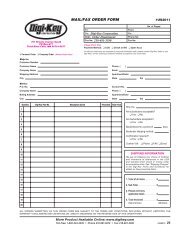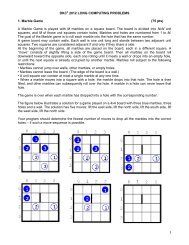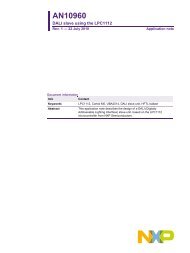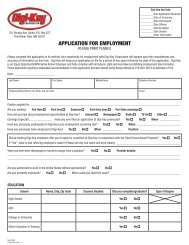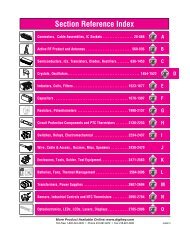Microcontroller Solutions TechZone Magazine, April 2011 - Digikey
Microcontroller Solutions TechZone Magazine, April 2011 - Digikey
Microcontroller Solutions TechZone Magazine, April 2011 - Digikey
You also want an ePaper? Increase the reach of your titles
YUMPU automatically turns print PDFs into web optimized ePapers that Google loves.
The thermistor used in the circuit is a 4.7 kΩ resistor, model number<br />
NCP18XM472. It is available in a 0603 surface-mount package.<br />
The thermistor used in the circuit in Figure 2 has the following<br />
specifi cations at 25°C: ß = 3500 (the ß parameter describes resistance<br />
as a function of temperature) and resistance (R 25<br />
) = 4.7 kΩ.<br />
The USB interface to the ADuC7122 is implemented with an FT232R<br />
UART to USB transceiver, which converts USB signals directly to the<br />
UART protocol.<br />
In addition to the decoupling shown in Figure 1, the USB cable itself<br />
should have a ferrite for added EMI/RFI protection. The ferrite beads<br />
used in the circuit are Taiyo Yuden, BK2125HS102-T, which have an<br />
impedance of 1,000 Ω at 100 MHz.<br />
The circuit must be constructed on a multilayer PC board with a<br />
large area ground plane. Proper layout, grounding, and decoupling<br />
techniques must be used to achieve optimum performance.<br />
Figure 2: A simple temperature sensor<br />
circuit implemented with the ADuC7122.<br />
The input thermistor circuit<br />
in Figure 2 is designed to<br />
produce accurate temperature<br />
measurements from 0°C to<br />
90°C. Note that this system<br />
contains no temperature<br />
calibration. This circuit<br />
contains a simple thermistor<br />
circuit that does not contain<br />
circuit linearization. If this<br />
circuit employed linearization<br />
techniques, it could function over a broader range of temperatures;<br />
however, this would decrease the resolution of the sensor.<br />
The circuit in Figure 2 is set up in a voltage divider confi guration. This<br />
will allow us to transform the ADC result, D, into a measurement of<br />
the resistance of RTH (thermistor) using the following formulas:<br />
<br />
= ∗ (<br />
( + ) )<br />
Figure 3: ADuC7122 thermistor sensor measured output (converted to volts) with ADC0<br />
versus temperature.<br />
Figure 3 plots the response of the ADuC7122 to the thermistor sensor<br />
detailed in Figure 2 over temperature.<br />
Code description<br />
The source code and a HyperTerminal confi guration fi le used to test<br />
the attached circuit can be downloaded as a zip fi le at www.analog.<br />
com/CN0153_Source_Code.<br />
The UART is confi gured for a baud rate of 9600, 8 data bits, no parity<br />
and no fl ow control. If the circuit is connected directly to a PC, a<br />
communication port viewing application such as HyperTerminal can<br />
be used to view the results sent by the program to the UART (Figure<br />
4). The source code is commented to make it easier to understand<br />
and manipulate. The code was compiled and tested using the Keil<br />
µVision 3 application.<br />
= 2 ∗ ( <br />
)<br />
<br />
<br />
= ∗ (<br />
= ∗ (( 2<br />
+ 1) ) )<br />
= 2 ∗ ( <br />
)<br />
<br />
Once the resistance of the thermistor is calculated, the Steinhart-Hart<br />
equation can be used to determine the ( 1<br />
current ∗ ) temperature of the sensor.<br />
= ∗ (<br />
Using the following formula, the<br />
(<br />
ADuC7122 <br />
2<br />
25<br />
<br />
)<br />
1)<br />
is able to determine the<br />
<br />
sensor temperature:<br />
2 =<br />
<br />
( 25 <br />
)<br />
( 1 ∗ )<br />
( 25 <br />
)<br />
2 =<br />
<br />
( 25 <br />
)<br />
where:<br />
T 2<br />
= unknown temperature<br />
V 1<br />
= 298K<br />
ß = ß parameter of the thermistor @ 298K or 25°C. ß = 3500<br />
R 25<br />
= resistance of thermistor @ 298K or 25°C. R25 = 4.7 kΩ<br />
R TH<br />
= resistance of thermistor @ unknown temperature as<br />
calculated by formula above<br />
Figure 4: Output of HyperTerminal communication port viewing application.<br />
Common variations<br />
The ADP3333 (3.3 V) can be replaced with the ADP120 (2.5 V),<br />
which has a wider operating temperature range (−40°C to +125°C)<br />
and consumes less power (typically 20 μA versus 70 μA) but has a<br />
lower maximum input voltage range (5.5 V versus 12 V). Note that<br />
the ADuC7122 can be programmed or debugged using a standard<br />
JTAG interface. For a standard UART to RS-232 interface, the FT232R<br />
transceiver can be replaced with a device such as the ADM3202,<br />
which requires a 3 V power supply.<br />
The thermistor circuit described here can be adapted to operate with<br />
other precision analog microcontrollers, such as the ADuC7020 series,<br />
the ADuC7023, and the ADuC7061 series.<br />
www.digikey.ca/microcontroller<br />
13



